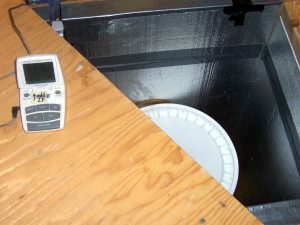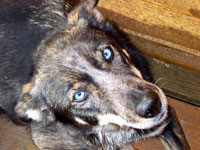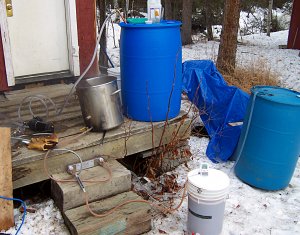
primary fermentation
Last weekend I brewed my favorite beer, Piper’s Irish-American Red Ale. I’m sure the beer will turn out fine, but the brew didn’t go as planned. I’m still struggling to get my mill to consistently produce a good crush, and I think my low yields this time around is almost certainly due to the mill. It’s a three roller mill; the first two rollers do a basic crush at a fixed gap, and then the grains pass between one of the top rollers and a lower roller that’s adjustable. For some reason, the grains sometimes come out between the lower roller and the wrong upper roller and they don’t get crushed a second time. Strange.
The big change with this brew was using Creek water to chill the boiled wort down to fermentation temperature. I’d assumed the Creek would still be very cold, but after pumping up twenty gallons, I discovered it was a balmy 55°F. So I pumped up another ten gallons in the hope that it would be enough to chill the wort. Not quite. I got it down to 72°F, which is pretty amazing, but I would have preferred something between 64–68°F.
Still, it was a nice relaxed brew session, and thus far Piper’s has always come out fantastic. We’ll know in about a month.
The other thing I’ve noticed is that the red cabin is starting to get too warm for primary fermentation. At our old house the garage temperature never got much above 60°F even in the summer, so I’d always do the primary fermentation in my insulated box, heated with a light bulb on a temperature controller. Luckily, we kept the old fridge that was here when we moved in and it’s keeping a nice stable 65°F on the same temperature controller I had been using to heat the fermentation chamber. Now I can ferment in the summer, and even experiment with lagering, which is a whole area of brewing that I’ve never attempted in all these years.
I’m between jobs right now, so I took advantage of the vacation and spring weather to brew a batch of rye India pale ale, Devil Dog. It’s named after our dog Kiva and is a rich, copper colored beer with lots of alcohol and a nice balance between malt and hops. Three pounds of rye (to twelve pounds of pale malt and a pound and a half of crystal malts) adds a subtle hint of spicy earthiness. This is the third time I’ve brewed it, but I got an unexpectedly good yield, so it’ll be stronger than past incarnations.
My normal brewing efficiency has hovered around 70% for many years, but has been falling over the past five or six batches. I think this was partly due to some bad base malt, and partly due to a worn out mill. I got a new sack of Crisp Maris Otter, and replaced my old mill with a Monster 3-roller Mill. Initially, I was having trouble with whole grains getting stuck between the upper passive roller and the wooden base that supports the mill. When this happened, the mill would seize because the passive roller couldn’t spin. My solution was to cut a piece of sheet metal (a tin can, actually) to span the gap between the base and the passive roller, so that all the grains are fed directly between the two top rollers. So adjusted, the mill is fantastic. My last two batches have had yields of 79 and 81%, and I had no trouble sparging this recipe, even with three pounds of rye malt in the mash.

kiva
The top photo shows my current chilling setup. I leave a 55-gallon barrel of water (the barrel up on the deck) out overnight to get cold, and pump this cold water through my plate chiller (on the steps) into a second barrel (the one on the ground). The beer drains by gravity through the other half of the chiller into the fermentation bucket. I monitor the temperature as the wort exits the chiller, and keep an eye on the temperature in the bucket with a digital meat thermometer. In my last batch I had trouble with the chiller cooling the boiling wort to much because the water was very close to freezing. But this time I figured out the correct combination of pump speed and output valve setting so I could adjust the temperature of the chilled wort without stalling the pump. Once the Creek thaws (it’s right behind the cabin), I’ll be able to use it for chilling instead of hauling my own chilling water.
Assuming the yeast is up to the task of this 1.086 gravity wort, I should be enjoying a pint of Devil Dog in six to eight weeks.
